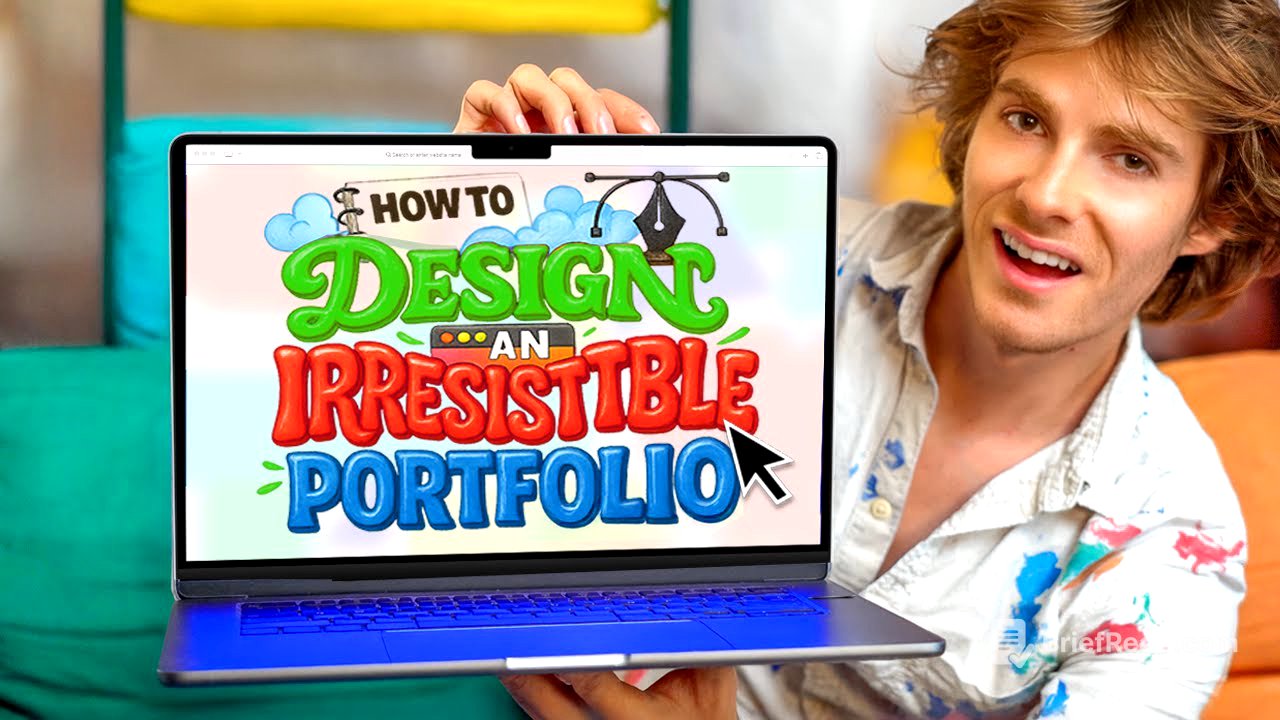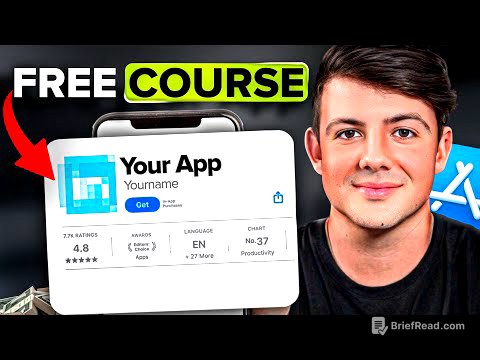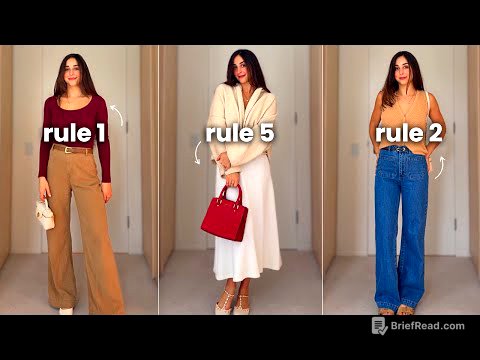TLDR;
This video provides a comprehensive guide on creating a design portfolio that effectively showcases your work and helps you land jobs or freelance opportunities. It covers essential elements such as displaying your best work upfront, understanding your target audience, explaining your work and its solutions, and injecting personality into your portfolio. The video also shares practical tips on website builders, resume customization, and tailoring your portfolio to specific job requirements.
- Showcasing best work upfront
- Understanding target audience
- Explaining work and solutions
- Injecting personality
How to Create a Design Portfolio That Sells [0:00]
The video introduces the key elements of a successful design portfolio, including website builders, project selection, and essential dos and don'ts. It promises to provide viewers with the tools and knowledge needed to create a portfolio that stands out and helps them achieve their career goals in the creative field. The video will showcase two different portfolios as examples.
Cinematographer Portfolio Example [0:35]
The video begins by examining the portfolio of a cinematographer, Andrew, highlighting its strengths. The most notable aspect is the immediate display of his best work upon visiting the website. This approach ensures that visitors are immediately captivated by the quality of his footage.
Should You Use a Demo Reel? [1:15]
The video advises against relying solely on demo reels, which often only show snippets of work. Instead, it emphasizes the importance of telling the full story behind each project. Andrew's portfolio effectively showcases his best work without requiring viewers to click on a separate demo reel, making it easily accessible and engaging.
Show Your Best Work Upfront [1:33]
The video emphasizes the importance of showcasing your best work immediately when someone visits your portfolio. This ensures that visitors are immediately impressed and engaged with the quality of your work.
Target Audience [1:42]
The video stresses the importance of understanding your target audience when designing your portfolio. For Andrew, the primary goal of his website is to attract freelance work. His website includes a "Get Started" button that leads to a contact form and a services page detailing his offerings in cinematography, photography, and animation. This setup is designed to appeal to potential clients seeking to hire him.
Explain Your Work [2:42]
The video highlights the importance of explaining the context and solutions provided by your work. Each video in Andrew's portfolio includes a description of his role and its significance. For instance, he explains how his video for Wake County Speedway helped them establish a digital presence with no prior marketing material. This additional information tells a more complete story and demonstrates the value he brings to clients.
Example #1 Recap [3:47]
The video recaps the key elements of Andrew's portfolio: showcasing the best work upfront, understanding the target audience, and elaborating on the solutions provided. These elements combine to create a compelling and effective portfolio.
Design Portfolio Example [4:00]
The video transitions to the presenter's portfolio, which differs significantly in style from Andrew's due to their different professional focuses. While Andrew is a cinematographer, the presenter is a YouTuber. The presenter's website is designed to attract sponsorships and collaborations for art projects, reflecting a playful brand.
Show Your Personality [4:53]
The video emphasizes the importance of incorporating personal branding into your portfolio to stand out. The presenter's portfolio showcases a playful brand with elements designed to attract sponsorships and collaborations. While personal branding isn't mandatory, making your portfolio personable helps create a memorable impression.
How to Display Your Work [5:27]
The video discusses different layout strategies for portfolios, noting that the presenter's layout is tailored to their diverse skill set and corporate experience. Unlike Andrew, who organizes his work by service (cinematography, photography, animation), the presenter organizes their portfolio by the solutions they provided to different companies. This approach is particularly effective for individuals with a wide range of skills.
How to Make Your Resume Stand Out [6:35]
The video provides tips on making your resume stand out, such as using a matching color scheme and brand to reflect your personality. The presenter includes unique experiences like being a TNT fireworks franchise owner and a Guinness World Record holder, which often spark interest and conversation during interviews. The presenter also hyperlinks sections of the resume to relevant portfolio pieces, enhancing interactivity.
My Secret 3 Rules for a Killer Portfolio [9:32]
The video introduces three key rules for creating an effective portfolio. These rules are designed to ensure that your portfolio is not only impressive but also practical and easy to manage.
Rule #1 Easy to Create and Update [9:42]
The video emphasizes the importance of creating a portfolio that is easy to create and update. The goal is to avoid procrastination and ensure that you can continuously improve your portfolio as your skills evolve. Whether it's a website, PDF, or Google Docs, choose the medium that allows for easy adjustments and additions.
Rule #2 Make it Easy to Navigate [10:47]
The video stresses the importance of ensuring your portfolio is easy to navigate for everyone, regardless of their technical skills. This includes friends, family, and potential employers. The portfolio should be user-friendly on both computers and mobile devices, with clear navigation and easily understandable content.
Rule #3 Make it Easy to Share [11:28]
The video highlights the need for your portfolio to be easily shareable. Whether it's via email or text, the medium you choose should allow others to forward your portfolio to hiring managers or clients effortlessly.
How to Make a Portfolio [12:00]
The video transitions to providing practical advice on how to create a portfolio, recommending the use of a website as the best medium. It suggests using website builders like Wix or Squarespace, based on their flexibility and ease of use.
What Website Creator to Use [12:12]
The video recommends using website builders like Wix or Squarespace to create a portfolio. These platforms offer templates and tools that make it easier to design and manage your online presence.
Wix vs Squarespace [12:27]
The video compares Wix and Squarespace, noting that Wix offers more flexibility but can be harder to use, while Squarespace is simpler and more user-friendly. The choice depends on your technical skills and the level of customization you desire.
How to Pick Your Best Work [13:20]
The video addresses the challenge of selecting your best work for your portfolio. It advises simplifying the process by limiting yourself to around 10 projects that truly represent your skills. While quantity isn't necessarily better than quality, include all work you're proud of, but prioritize the best pieces to avoid overwhelming viewers.
Should You Use Group Projects? [15:35]
The video encourages including group projects in your portfolio, provided you clarify your role in the collaboration. Highlighting your contributions to successful team projects can demonstrate valuable teamwork and collaboration skills.
Use Mockups! [16:20]
The video advises graphic designers to use mockups when showcasing logos or designs. Placing your work in realistic contexts, such as on flyers or posters, enhances its visual appeal and professionalism.
Sell Solutions! [16:37]
The video emphasizes the importance of selling solutions rather than just services. Like Andrew's portfolio, focus on the value and impact of your work, whether you're applying for a job or seeking freelance opportunities.
Why You Should Add Metrics [17:24]
The video highlights the value of including metrics to demonstrate the impact of your work. Even for personal projects, metrics like the number of views on an Instagram reel can add credibility and tell a more compelling story.
How to Tailor Your Portfolio [18:52]
The video advises tailoring your portfolio to align with your goals. If you're applying for a specific job, review the job description and highlight the skills and experiences that match the requirements.
How to Write a Cover Letter or Killer Email [19:11]
The video shares a strategy for writing effective cover letters or emails, called the "three-reason rule." This involves identifying three reasons why you would be a great fit for the job or client, customizing your message to demonstrate your understanding of their needs.
Don’t Forget to Use Your Portfolio! [21:48]
The video concludes by emphasizing the importance of actively using your portfolio during interviews or client meetings. Whether in person or via video call, showcasing your work and walking through your best pieces can significantly increase your chances of success.
Skillshare Ad 😛 [22:36]
The video includes a promotion for Skillshare, offering viewers a discount on their first year of membership. Skillshare provides a variety of classes on topics such as portfolio building, business, and design.









